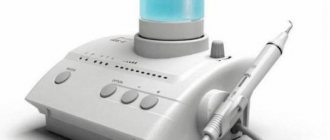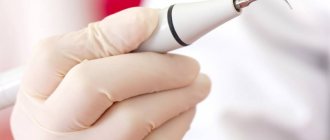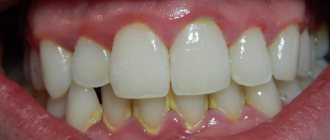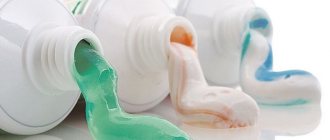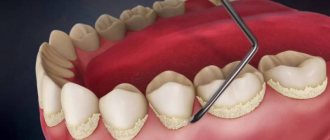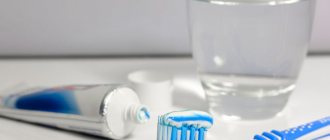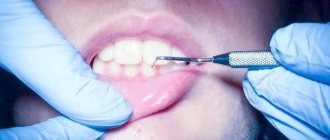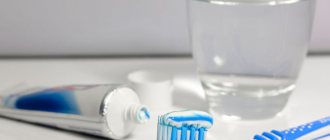Ultrasonic teeth cleaning is one of the safest and most gentle methods of deep teeth cleaning. Even if you systematically and carefully take care of your oral health, over time, plaque, pigmentation and very hard tartar will still form on your teeth, the removal of which is impossible without dental care.
The activity of bacteria causes the appearance of an acidic environment in places where microorganisms accumulate, which leads to bad breath, the formation of caries, bleeding and inflammatory processes of the gums and the active growth of stones that can penetrate into the space under the gums. As a result, the ligamentous apparatus of the tooth is destroyed and periodontal pockets are formed, the teeth become loose and begin to fall out. In addition, the formation of tartar and the growth of pathogenic bacteria in the oral cavity can cause diseases of the gastrointestinal tract, heart and respiratory system. To prevent and treat these problems, professional cleaning methods are used using special devices that do not damage tooth enamel and do not take much time.
What is tartar and what are the causes of its appearance?
Tartar is hardened plaque that forms on the visible part of the tooth (crown) and under the gum.
The reasons for its appearance are natural, but the consequences can cause pathologies in the oral cavity.
Initially, food particles stick to the enamel. Bacteria begin to actively multiply in them. A dental plaque is formed, which looks like a soft, light plaque. Plaque can be easily removed by regular tooth brushing. But if this does not happen, then food debris, dead cells of the mucous membrane, calcium and phosphorus salts from saliva are layered on the soft plaque. They crystallize and harden.
Mineralization occurs on average within 12 days. Soft plaque turns into hard plaque. Tartar has a rough surface, onto which more and more elements “cling.”
Attention: A bacterial film on teeth forms within 16 hours. Therefore, it is important to brush your teeth at least twice a day.
Photo of plaque, male jaw
Why hard deposits form
Plaque formation is inevitable, but there are a number of factors that accelerate the process:
- Irregular hygiene. Particularly active formation of plaque and stone occurs at night: salivation decreases, a person swallows less often, and does not move the tongue. This creates a favorable environment for bacterial growth.
- Poor hygiene. Brushing teeth with horizontal movements does not affect hard-to-reach areas. The interdental spaces should be cleaned by moving the brush vertically.
- Diet. A large amount of sweet and starchy foods leads to the sticking of carbohydrates to the enamel and the proliferation of pathogenic microflora. To reduce the rate of plaque formation, you should eat fresh, firm vegetables and fruits. Chewing the fibrous pulp for a long time partially helps remove plaque.
- Physiological features. Incorrect bite and crowded teeth make proper cleaning difficult.
- Metabolic disorders. The composition of saliva changes, its bactericidal properties decrease.
- Smoking. Cigarette tar settles on the teeth, causing the formation of films and plaques.
Hygienic cleaning
To maintain hygiene at home, manufacturers produce a number of products. It will not be possible to completely clean the enamel at home; with the greatest efforts, only 55% of plaque is removed. The remaining 45% are in hard-to-reach places - under the teeth or gums.
These unremoved plaque residues are enough to cause caries, periodontitis, and tartar in a person.
Hygienic cleaning by a doctor is carried out using a brush and specialized hooks. This measure completely prevents the development of caries and ensures a naturally snow-white smile and surprisingly smooth enamel. Manual cleaning by a dentist has no contraindications and is carried out twice or thrice a year.
Why is ultrasonic cleaning necessary?
Professional teeth cleaning in a clinic identifies problem areas and helps avoid future diseases.
- Detects caries. The destruction of enamel and dentin can be hidden under a layer of tartar. If caries is discovered later, it should be cured.
- Prevents the formation of new caries, including those who wear braces.
- Prevents gum inflammation, periodontitis, exposed roots, bleeding, and bad breath.
- Prepares the oral cavity for surgery and implant installation. Removing colonies of bacteria living in dental plaque ensures the safety of manipulations that violate the integrity of tissues.
- Brightens teeth without aggressive chemical whitening.
Photos BEFORE and AFTER cleaning
Oral care after brushing
After teeth cleaning in a clinic, you can regain your beautiful and healthy smile. But in order to prolong this effect, you should follow some rules:
- Brush your teeth every time after meals for the first few days, using toothpaste containing fluoride. The toothbrush should be soft. After a week, you can return to using a brush with medium hardness characteristics.
- Smokers will have to give up cigarettes for at least two weeks, since tobacco smoke will intensively change the color of tooth enamel.
- It is not recommended to eat too hot or cold foods, as well as sweet and sour foods, which can increase tooth sensitivity.
- For several days it is necessary to completely avoid drinks and fruits that can stain the enamel.
- If discomfort and pain occur, it is recommended to treat soft tissues with special preparations.
The rules listed above apply only to the first days after cleaning. In order for the result to be as long as possible, you need to:
- change your toothbrush every 2 months;
- use not only high-quality toothpaste, but also mouth rinses;
- brush your teeth morning and evening;
- use dental floss;
- eat hard fruits and vegetables;
- visit the dentist every six months.
Is ultrasonic teeth cleaning harmful?
Ultrasonic cleaning does not pose any threat to teeth and the body as a whole. An exception is situations in which the technology is broken or the patient has contraindications. Ultrasound can damage enamel if it is thinned or has such a structural feature. Sometimes brushing causes bleeding from the gums. The doctor will help stop it and advise what needs to be done for speedy healing.
Advice: to avoid possible troubles, before starting the procedure, the dentist finds out the state of health, concomitant diseases, and reaction to medications. Answer honestly and directly, every nuance matters.
Can restrictions be removed?
Thanks to the fact that many clinics in St. Petersburg conduct regular promotions aimed at attracting new patients, the price of hygienic teeth cleaning using ultrasound is affordable to almost everyone today. A mandatory component of the procedure is a preliminary examination, during which possible contraindications are identified. Additional treatment prescribed in such cases may increase the cost of the service, but it is a necessary condition.
Considering diagnosed viruses and infections as limiting factors is associated with concern for the health of not only the patient, but also the doctor. An organism susceptible to pathology is capable of responding inadequately to treatment - under the influence of ultrasonic waves, an increase in cellular metabolism is possible, so you should wait until complete recovery.
Limitations associated with heart disease, as well as the presence of pacemakers, are caused by the effect of ultrasound on the circulatory system. Heart rhythm disturbances pose a threat to human life, which leads to recommendations for choosing other methods of professional dental cleaning.
Doctors advise refraining from ultrasonic cleaning during pregnancy, as well as in the first months after the birth of a child. This is due to the sensitivity of the body, which increases at these stages - external influences can negatively affect the patient’s well-being, as well as provoke an unplanned reaction. An option recommended when planning a pregnancy is to carry out dental procedures a couple of months before conception, which allows you to avoid situations that require an urgent visit to the clinic.
Pros and cons of ultrasonic tartar removal
Unlike other methods, ultrasonic cleaning has a number of advantages:
- Removes subgingival calculus that is difficult to reach with traditional instruments. To clean the root zone, the doctor pulls back the gums and works with the neck and root of the tooth.
- Cleans the interdental spaces even of very dense teeth, uneven, overlapping one another.
- The procedure does not last long - 40-60 minutes.
- Painless. The patient does not feel any impact.
- Non-contact influence. Only air and water come into contact with teeth. With the outdated mechanical method, the instruments scratch the enamel and cause an unpleasant “grinding” sensation.
What is prohibited after professional teeth cleaning?
The procedure increases the sensitivity of the enamel, so dentists are categorically against smoking during this period. You should also not eat food containing artificial or natural colors - coffee drinks, any types of tea, wine made from red grapes.
Beetroot juice, carrots, and berries that have an intense black, blue, and red color act in a similar way.
It is forbidden to drink liquids that increase the sensitivity of tooth enamel. These include highly carbonated drinks, lemon and apple juice. It is forbidden to use rinses containing alcohol for two weeks; a brush with hard bristles is not recommended.
Main stages of ultrasonic processing
The dentist conducts an examination, identifies places where tartar accumulates, the amount, and determines its density in order to choose the appropriate cleaning regimen. Sometimes teeth are treated with a special solution that reveals the boundaries of plaque. If the patient has sensitive teeth, gums or deep subgingival calculus, anesthesia (injection or application) is performed.
Stone removal is carried out in three stages:
Brushing teeth with a skyler
Skyler is a dental instrument that generates ultrasonic air vibrations. Water (an antiseptic solution) mixed with air is sprayed through a narrow nozzle. The liquid is intended to cool the tooth and wash away the separated plaque.
The ultrasonic wave forms cavities in mineralized deposits, the plaque cracks and peels off from the enamel. The fragments are removed with a saliva ejector.
First, the doctor cleans the crowns, then the subgingival area, guiding the scaler with parallel vertical movements.
Brushing teeth with a skyler
Polishing
Cleaned teeth have a rough surface. To slow down the adhesion of food and bacteria, polishing is used.
Main types:
- Mechanical with special paste and a round elastic brush. The interdental spaces are polished with thin strips or narrow spiral-shaped brushes.
- Hardware using the AirFlow method - using a powerful jet of water with an abrasive containing sodium bicarbonate.
Brushing your teeth with a special paste and a round brush
Fluoridation
Fluoridation helps strengthen enamel and reduce hyperesthesia (sensitivity) in the cervical area.
- The tooth surface is dried with a stream of warm air for better adhesion.
- Apply a composition containing fluoride ions (gel or varnish) and dry again.
- The teeth are treated with a swab soaked in copper hydroxide and calcium solution. The substances enter into a chemical reaction, and calcium fluoride crystals are formed in the dentinal tubules and other irregularities, which strengthen the tooth tissue and prevent infection.
The most frequently asked questions from patients about the procedure
How painful is it?
(click to expand) Ultrasound teeth cleaning is a painless procedure, but it may be accompanied by minor discomfort in the presence of subgingival dental deposits - to remove them you need to slightly disturb the gums. Patients with increased sensitivity of the enamel may also complain of pain. In such cases, the doctor will perform cleaning with maximum comfort for the patient, using local anesthesia.
Is ultrasonic cleaning whitening? (click to expand) No, whitening is a completely different procedure, it is carried out using special whitening compounds that are applied to the tooth. A slight lightening of the enamel is due to the fact that after ultrasonic cleaning, the surface of the teeth is polished; sometimes the difference in color is clearly visible.
Is it true that plaque appears on teeth faster after ultrasonic cleaning? (click to expand) No, that's not true. On the contrary, after ultrasonic cleaning followed by polishing the enamel, plaque appears more slowly. Maintaining oral hygiene helps prevent its occurrence: responsible brushing of teeth at least 2 times a day, rinsing the mouth after meals, choosing the right toothpaste. Smoking, excessive consumption of tea and coffee, and metabolic disorders in the body contribute to the rapid appearance of plaque.
Can cleaning damage the enamel? (click to expand) If the procedure is carried out correctly, damage to tooth enamel is excluded. After cleaning, weak and thin enamel is additionally strengthened with remineralizing gels, the enamel is actively saturated with microelements, and it becomes stronger.
What should I do if I have an acute inflammatory process on my gums? (click to expand) Acute inflammation of the gums, accompanied by bleeding, in most cases is a contraindication to ultrasonic teeth cleaning until acute symptoms are relieved. We offer our patients tartar removal simultaneously with gum treatment using the Vector device. This is a specially designed ultrasonic scaler that is equipped with a unique Paro tip that creates special ultrasonic vibrations. The device allows for deeper treatment of periodontal pockets if the patient is diagnosed with periodontitis; Simultaneously with the removal of dental plaque, the enamel is polished with a special polishing liquid. After its use, supragingival and subgingival deposits, inflammation of soft tissues and bleeding are completely eliminated, bad breath disappears, and oral health is restored.
Is the procedure allowed during pregnancy? (click to expand) Ultrasonic teeth cleaning is not only allowed for pregnant women, but is also recommended for mandatory use. This is explained by the frequent occurrence of problems with teeth and gums in pregnant women due to hormonal changes and the need to sanitize the oral cavity before childbirth. The procedure is completely safe for the health of the expectant mother and her baby, but you still need to consult a gynecologist before performing it.
How often should you resort to ultrasonic teeth cleaning? (click to expand) We recommend that our patients have their teeth cleaned with ultrasound every 6-12 months; sometimes, if there is an increased tendency to form plaque, cleaning is done more often. The best solution is to carry out a comprehensive oral hygiene cleaning, which helps maintain oral health and fresh breath.
Ultrasonic teeth cleaning helps prevent the development of many dental diseases, so do not neglect this procedure.
Contraindications
The most important contraindication is the presence of a pacemaker in the patient. Ultrasonic waves can disrupt its operation.
Other restrictions also apply to health conditions:
- asthma, bronchospasm, tuberculosis,
- increased risk of bleeding,
- allergies to the drugs used,
- infectious and viral diseases,
- oncology,
- mental illness, epilepsy.
Attention: Relative contraindications are pregnancy (first trimester), childhood (up to 16-18 years). The decision to perform the procedure is made by the dentist.
Price
The cost of ultrasonic teeth cleaning is determined individually; it depends on several factors:
- state of the dentition;
- availability of additional procedures;
- clinic categories.
If a dentist has to remove plaque and stones from all teeth, the cost of the procedure will be quite high. A patient who regularly undergoes professional treatment will not have to spend a lot of money.
After eliminating the formations, a number of additional procedures can be carried out: polishing, fluoridation, the cost of which is included in the total amount.
In high-category clinics, the price of cleaning is usually higher, since they employ highly qualified specialists and use effective drugs.
When it might be painful or unpleasant
Ultrasonic cleaning is a modern, effective method with minimal trauma. Most patients tolerate the process without discomfort.
Pain when cleaning with ultrasound
Pain can occur due to individual characteristics or due to erroneous actions of the doctor.
Features include thin, sensitive enamel - a semblance of shocks and pressure is felt. Weakened gums that are prone to bleeding are easily subject to microdamage and painful sensations appear. If there is extensive subgingival calculus, the doctor works in this area for a long time, which can also lead to discomfort.
Is there any discomfort during laser cleaning?
This method does not cause pain. The laser beam destroys pigments and evaporates water in hard and soft deposits. Their remains are washed off from the surface with water. In this case, there is no effect on the enamel. Gum pockets are not treated with laser; therefore, there is no contact with soft tissues.
Features of chemical tartar removal
The method is rarely used, because has few advantages, including speed and affordable price. Chemical removal has more disadvantages: thinning of the enamel, possible burns of the mucous membrane if performed incorrectly, poor cleaning of the interdental space, allergies to the products used, oxidation of orthodontic metal structures.
Sequencing:
- installation of protective plates on the gums,
- applying acidic and alkaline compounds for 2-3 minutes,
- rinsing, polishing, fluoridation.
Chemical removal of tartar
How painful is it to remove stone manually?
This contact method can only be painful if the doctor's hand accidentally slips and the instrument scratches the gum. Also, the disadvantages include incomplete removal of plaque and stone in hard-to-reach places. Mechanical cleaning is contraindicated for thin, sensitive enamel, inflammation of the gums, and infectious lesions of the mucous membrane.
Nowadays, dentists recommend removing tartar manually less and less often.
How does the cleaning procedure work?
Using a special scaller tube, water pressure is applied to the surface of the teeth, which protects the teeth from overheating, and high-frequency sound.
Ultrasound has a destructive effect on dental plaque and hard deposits. The doctor carefully removes tartar and soft plaque without damaging the enamel. Moreover, the procedure does not cause any discomfort. To make it more effective and safe, the doctor individually selects the frequency of oscillations and the intensity of the water supply. Sometimes a special gel is applied to the teeth, which increases the effectiveness of cleansing. It is very important that the doctor explains his actions during the procedure and at the end gives advice on preventing the formation of tartar and further oral care.
In complex cases, several treatment sessions may be required. Therefore, to improve the quality of teeth cleaning after ultrasound, the Air Flow device is used. In this case, a pressure of water with air and sodium carbonate-based powder is directed onto the teeth. This allows you to more effectively clean the most inaccessible places where even ultrasound could not penetrate. In addition to cleaning, this procedure gently and safely whitens and polishes teeth.
After cleaning, the enamel may be sensitive for some time. Therefore, all medical procedures can be carried out only after a few days. It is not recommended to put braces and dentures on your teeth immediately after cleaning.
Myth #8: Professional cleaning cannot be done with braces.
Many people think that it is better to forego professional hygiene with braces so as not to damage the structure. But braces make home oral hygiene very difficult, and dentists advise those who wear them to have them cleaned in the clinic once every 3-4 months, as well as use beauty gadgets to clean their teeth at home.
Dentist's opinion: such frequency will help to avoid the development of multiple caries and destructive changes in tooth enamel during orthodontic treatment. You can also purchase an oral irrigator for home care.
Ultrasonic teeth cleaning before and after photos of our patients
Photo before
Photo after
Photo before
Photo after
Photo before
Photo after
In terms of its action, a dental scaler is a universal tool, since its use allows you to remove tartar from the enamel, as well as efficiently clean the space under the gums and between the teeth from pathogenic microorganisms.
Ultrasonic teeth cleaning is carried out without anesthesia, since all manipulations performed by the doctor are absolutely painless for the patient and do not cause any discomfort.
Ultrasound cleaning does not entail negative side effects, but quite the opposite - it helps prevent diseases of the teeth and gums and improve their health. Reviews of ultrasonic teeth cleaning from patients confirm that this method is not only painless and safe, it is most effective!
Cleaning teeth from plaque using the Air Flow method
Unlike the ultrasonic method, Air Flow is the effect of air flow together with an abrasive on hard plaque. The abrasive material is soda, which is applied along with a thin stream of water. Adding menthol or lemon flavors to water gives a refreshing effect. Small particles of soda hitting the enamel due to the air flow do not harm the teeth. They effectively cope with soft and hard plaque in gum pockets and interdental spaces.
Brushing your teeth with water reduces the heating of enamel during the hygiene procedure. This professional method helps in effectively removing plaque and tartar, and thoroughly polishes the enamel.
In addition to being used as a comprehensive approach, air brushing is suitable in the following cases:
- implants, crowns, and other orthodontic structures are installed in the mouth, as well as if braces or implantation are to be removed;
- problems with gums at the initial stage or there is plaque that has not yet turned into tartar;
- severe pigmentation of teeth due to smoking, coffee abuse and foods with dyes.
The professional Air Flow technique is safe and painless, has a gentle effect, and cannot cause an allergic reaction.
If preventive teeth cleaning is not carried out as part of a comprehensive procedure, the effect will be short-lived. For a more lasting result, it should be done about four times a year.

